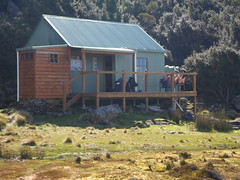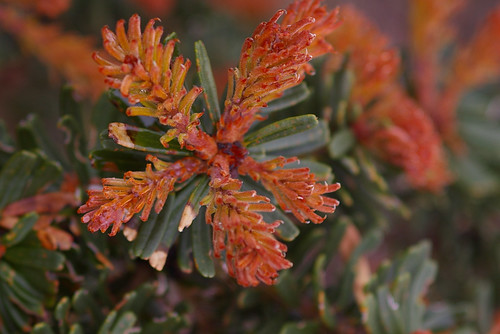The rebuilt Lady Lake Hut on the Central Plateau at the end of Higgs track is only a 2 hour walk from the carpark.
The hut is one of the most comfortable and well built huts I have ever stayed in.The huts has a metho heater and metho burners so all you need to bring is the fuel.
This blog is dedicated to my love of nature,particularly my passion for Tasmania's native flora and buswalking in this beautiful island of Tasmania.
Tuesday, November 23, 2010
Lady Lake Hut
Labels:Tasmanian Plants,Bushwalking,
Central Plateau,
Lady Lake Hut-Rotulis Tassie Bush Blog
Friday, October 15, 2010
Vale of Belvoir- Threatened Highland Grassland Community
The Vale of Belvoir Vale of Belvoir is an important Highland Grassland Higland Grasslands near Cradle Mountain that has been bought by the Tasmanian Land Conservancy .
The Highland Poa grassland and Highland grassy sedgeland are threatened vegetation communitiesHighland Poa Grassland that are of high conservation value.
The Vale of Belvoir protects a number of rare and threatened plants and animals.
The Tasmanian Land Conservancy describes the Vale of Belvoir -
"It is the only surviving grassy valley of its kind, unchanged since the time of the wallaby hunters of southwest Tasmania 18,000 ~ 20,000 years ago, when glaciers covered much of highland Tasmania.
The valley is widely recognised as one of the most important places for nature conservation in Australia. Five hundred hectares of private land sit, in the core of this conservation garden, which lies in a region now undergoing rapid development.
 |
| Xerochrysum subundulatum and the rare rhodanthe anthemoides at the Vale of Belvoir |
 |
| The vulnerable Stackhousia pulvinaris |
 |
| Lake Lea in the Vale of Belvoir |
The Highland Poa grassland and Highland grassy sedgeland are threatened vegetation communitiesHighland Poa Grassland that are of high conservation value.
The Vale of Belvoir protects a number of rare and threatened plants and animals.
 |
| RTBG staff collecting at the Vale of Belvoir |
The Tasmanian Land Conservancy describes the Vale of Belvoir -
"It is the only surviving grassy valley of its kind, unchanged since the time of the wallaby hunters of southwest Tasmania 18,000 ~ 20,000 years ago, when glaciers covered much of highland Tasmania.
The valley is widely recognised as one of the most important places for nature conservation in Australia. Five hundred hectares of private land sit, in the core of this conservation garden, which lies in a region now undergoing rapid development.
Please take a look at the video link by the Tasmanian Land Conservancy to see the beauty of this spectacular area that is one of my favourite places :http://www.youtube.com/watch?v=qPkKY3-YwjQThe tussock grasslands of the Vale of Belvoir are home to shy ground parrots, rare Ptunarra brown butterflies and numerous wildflowers. It is also home to one of the densest populations in the world of marsupial carnivores, including the vulnerable Spotted-tailed quoll and endangered Tasmanian devil".
Labels:Tasmanian Plants,Bushwalking,
Rotuli's Tassie Bush Blog-Vale of Belvoir,
Sub alpine grasslands,
Vale of Belvoir
Tasmanian Bush Huts
.JPG) |
| Cooks Beach Hot-Freycinet Peninsula |
I will add more images of huts around Tasmania as I visit.Drop me a line if you know of any hidden huts,particularly on the Central Plateau.
 |
| Lake Dobson Huts-Mount Filed National Park |
 |
| Tommy McCoys Hut at February Plains |
 |
| Tommy McCoys Hut at February Plains as used by Basil Steers. |
 |
| Inside fireplace at Tommy McCoys Hut |
 |
| Lewis Lees Hut at Lees Paddocks |
 |
| Lake Ina Hut |
 |
| Inside of Lake Ina Hut |
 |
| Gingerbread Hut Mount Rufus |
 |
| Joe Slater Hut at Mt Rufus |
 |
| Lewis Lees Hut at Lees Paddocks |
Labels:Tasmanian Plants,Bushwalking,
Lake Ina Hut,
Lewis Lees Huts,
Rotuli's Tassie Bush Blog,
Tasmanian Huts,
Tommy McCoys Hut
Wednesday, October 13, 2010
Cyttaria gunnii
 |
| Closeup of Cyttaria gunnii at Lee's Paddocks |
Cyttaria gunnii is a parasitic fungus only associated with Nothofagus cunninghami in Tasmania and Victoria in cool temperate rainforest.The fungus is edible and is only observed in spring and summer.
The fungus doesn't kill the host tree but causes fungal galls on the tree that can re appear year after year with no apparent ill affects to the tree.
 |
| Cyttaria gunnii covering a Nothofagus cunninghami |
The Genus Cyttaria has about 10 species and is only found on Nothofagus species .The other species of the Genus can be found in New Zealand and South America.
Labels:Tasmanian Plants,Bushwalking,
Myrtle Orange,
Rotuli's Tassie Bush Blog-Cytaria gunnii
Thursday, September 30, 2010
Banksia Marginata-many growth forms
Banksia marginata or silver Banksia Banksia marginata Pdf is perhaps the most variable of all the banksias found in Australia.
 |
| common colour of Banksia marginata flower |
In Tasmania it can be found from coastal areas to alpine areas at 1200 metres above sea level.
It can be a prostrate shrub in coastal areas such as Cape Pillar or a small shrub in alpine areas or a tall shrub/small tree in open woodland or wet forest as on the Gordon River in the Vale of Rasselas.
This species may posses a lignotuber or have no lignotuber at all and both can be found in a single population growing next to each other.
The leaves of this species are extremely variable and can be linear,oblong or narrowly wedge shaped/lance shaped with entire margins or even serrated margins. The leaf tip can be either blunt or have a distinct point.Leaf size is also extremely variable from 1 to 10 cm long and from 3-20 mm wide.
The upper side of the leaf is dark green and the underside of the leaf is white and quite hairy.
The flowers of this species are usually a golden yellow colour but they can also be green,rusty brown or even pink from 3cm long up to 20 cm long on some sub alpine forms..
The Royal Tasmanian Botanical Gardens in Hobart has a number of different forms in its collections,in particular there is a bed planted out with mainly low growing forms of Banksia marginata near their Visitor Centre at the Greater Hobart Garden and the French Memorial Fountain.
It can be a prostrate shrub in coastal areas such as Cape Pillar or a small shrub in alpine areas or a tall shrub/small tree in open woodland or wet forest as on the Gordon River in the Vale of Rasselas.
This species may posses a lignotuber or have no lignotuber at all and both can be found in a single population growing next to each other.
The leaves of this species are extremely variable and can be linear,oblong or narrowly wedge shaped/lance shaped with entire margins or even serrated margins. The leaf tip can be either blunt or have a distinct point.Leaf size is also extremely variable from 1 to 10 cm long and from 3-20 mm wide.
The upper side of the leaf is dark green and the underside of the leaf is white and quite hairy.
The flowers of this species are usually a golden yellow colour but they can also be green,rusty brown or even pink from 3cm long up to 20 cm long on some sub alpine forms..
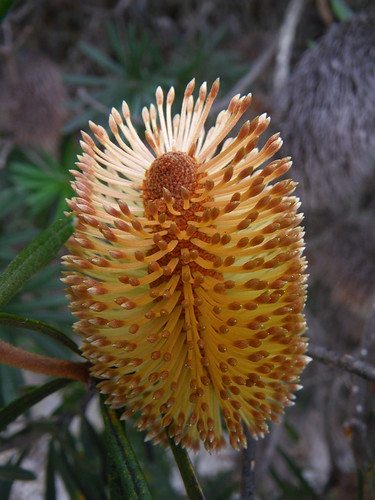 |
| Unusual flower colour on Banksia marginata at Drip Beach near Cygnet |
The Royal Tasmanian Botanical Gardens in Hobart has a number of different forms in its collections,in particular there is a bed planted out with mainly low growing forms of Banksia marginata near their Visitor Centre at the Greater Hobart Garden and the French Memorial Fountain.
The Gardens has the following Tasmanian forms,Mini Marge,Coastal Spread,Petal Point Prostrate,Cole's Bay Compact and selections from South Arm and South Port Bluff.
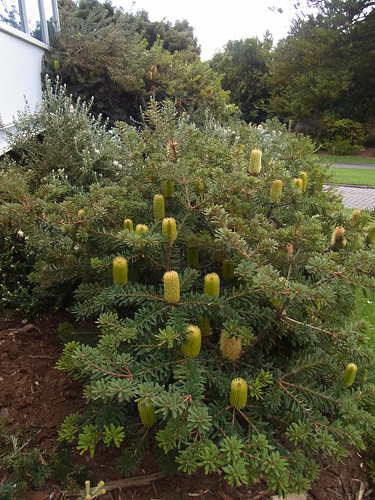 |
| Banksia marginata forms bed at the Royal Tasmanian Botanical Gardens |
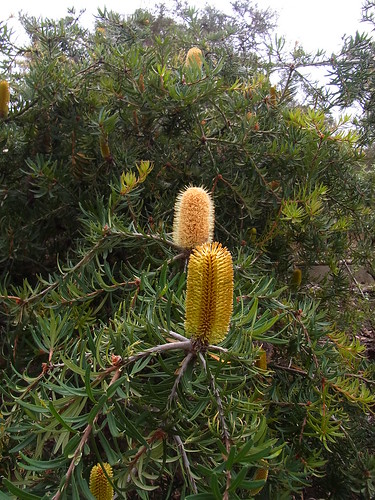 |
| South Arm selection of Banksia marginata at the Royal Tas Bot Gardens |
Below is a list of localities in the state that I have noticed particular forms :
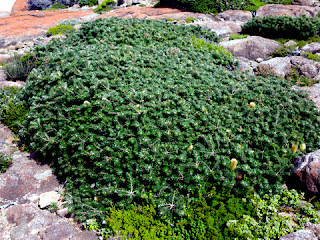 |
| Prostrate form of Banksia marginata at Cape Pillar |
This area of North Eastern Tasmania has a number of miniature and low growing forms of Banksia marginata which aren’t in cultivation yet.
Southern Forests
This area south of Hobart has forms with linear leaves and looks very similar to Banksia spinulosa if you look at it from a distance, I discovered a couple of specimens that had good horticultural potential but as they were in State Forest the area was logged before I could propagate them, please see image below
Denison Range-There are several very bushy forms found on this range that never get more than 2 metres tall by up to 3 metres wide,see images below :
Harts Hill Reserve-I recently discovered a low growing form 40cm tall by 1.5 metre
wide and another form that is 1.8 metres tall by 2 metres wide in this reserve please see images below
:
 |
| Harts Hill bushy form of Banksia marginata |
 |
| Harts Hill low growing form of Banksia marginata |
This area has forms very similar to Cape Pillar,but they appear to be more upright than the very prostrate forms on Cape Pillar.
 |
| Prostrate form of Banksia marginata at Cape Raoul |
 |
| Green flowered form of Banksia marginata at Cape Raoul |
Petal Point-This area in North East Tasmania has many interesting forms of Banksia from low bush forms from one sold by Pulchella Nursery at Buckland that is nearly prostrate See image below :
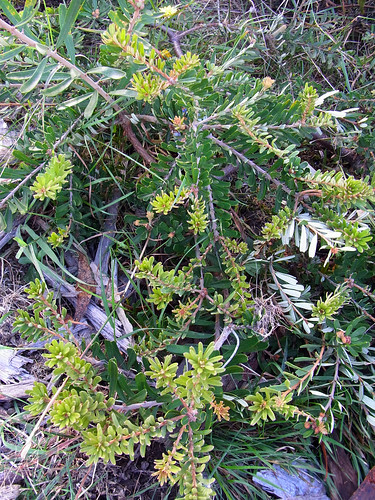 | ||
| Petal Point prostrate form growing in our garden.
|
In cultivation this species needs a well drained acid soil in full sun or part shade.
Banksia marginata will tolerate drought and extremes of temperature once established,depending on the provenance of the parent plant.
Banksia marginata responds well to a light feed of Blood and Bone or a similar low phosphorus fertiliser in spring and Autumn.
Propagation
Propagation
Banksia marginata is easy to propagate from seed ,although you may need to stratify the seed if it comes from alpine environments.I have observed that seed collected from Banksia marginata in Alpine/ subalpine environments are more prone to damping off then seed collected from lower altitudes,I am not sure why this is yet as I treat all seed the same,will keep you up to date if I discover why this is so.
Banksia seed should be sown in a well drained seed mix designed for natives,in either a seedling punnet or a small square pot as drainage is critical if you are to avoid damping off,a fungal disease caused by poor drainage and lack of air movement.
Some Banksia seedlings also seem prone to Chlorosis,which shows up as a yellowing of the leaves,this can be corrected by applying iron chelates.
Banksia seed should be sown in a well drained seed mix designed for natives,in either a seedling punnet or a small square pot as drainage is critical if you are to avoid damping off,a fungal disease caused by poor drainage and lack of air movement.
Some Banksia seedlings also seem prone to Chlorosis,which shows up as a yellowing of the leaves,this can be corrected by applying iron chelates.
 |
| Seedling showing signs of Chlorosis |
 |
| Seedling from Cape Pillar Prostrate form that seems to becoming true from seed. |
 |
| Banksia seedlings germinating in a seed punnet |
Propagation from cuttings is recommended if you are trying to propagate a particular form,semi hardwood cuttings in late summer/Autumn are recommended but sometimes are slow to strike so be patient...
Labels:Tasmanian Plants,Bushwalking,
Banksia marginata,
Proteaceae,
Rotuli's Tassie Bush Blog,
Royal Tasmanian Botanical Gardens,
Silver Banksia,
Tasmanian Plants
Sunday, September 26, 2010
Boronia rozefeldsii
Boronia rozefeldsii is a species that is only found on Schouten Island of Tasmania's East Coast,it is a plant with great horticultural potential as it has quite showy flowers.This plant grows on granitic soils with very good drainage.
Labels:Tasmanian Plants,Bushwalking,
Boronia rozefeldsii,
Schouten Island,
Tasmanian Plants
Saturday, September 25, 2010
Anogramma leptophylla
 |
| Anogramma leptophylla at Bluff River Gorge |
The Annual Fern Anogramma Pdf as it is commonly called is a species of dry habitats in Tasmania and is currently classified as vulnerable under Tasmanian Threatened Species Legislation.This species is found on dolerite and sandstone commonly at the top of gorges,it is quite probable that it has been overlooked as an immature fern of other species
This fern appears after a good period of rainfall then disappears when the environment drys out.This photo is taken at Bluff River Gorge where we found a new site for this vulnerable species.
.
Labels:Tasmanian Plants,Bushwalking,
Anogramma leptophylla,
Bluff River Gorge,
Rotuli's Tassie Bush Blog,
Tasmania,
Tasmanian Plants,
vulnerable
Telopea truncata
 |
| Telopea truncata at Hartz Mountain National Park |
Telopea truncata or Tasmanian Waratah is one of my favourite plants in the Tasmanian bush,the most common flower colour is red but there are other colours such as yellow ,white and pink Telopea flower colours.
The Tasmanian Waratah is a slow growing plant of the sub alpine zone but can be found at lower altitudes on the Tasmanian Peninsula. It can also be found in drier areas such as Platform Peak in the south east,Snow Hill in the Eastern Tiers and even a record from Brown Mountain in the South East.
 |
| Round leafed form of Telopea truncata found at Cape Pillar |
 |
| Seed follicles forming on Telopea truncata at Cape Pillar |
In cultivation you need a cool and protected site and the soil must be very well drained but moist ,as they will die in waterlogged soil.Waratahs benefit from fertilising with Blood and Bone or any fertiliser low in phosphorous at least once a year in spring.
Telopea truncata in cultivation on our block collcted from Snug Tiers.
\
 |
| Telopea truncata growing on Snug Tiers |
Waratahs are easy to propagate from fresh seed(less than 6 months old),but you will loose allot of them because of damping off Damping off, you could spray them with a fungicide such as Banol PDF or better still you could make sure the seedling mix is not kept to damp and has plenty of air movement around the punnets which will help control this disease.
Waratahs benefit from pruning off the old flower heads(if you don;t want to collect the seed) to promote a bushy plant that will have more flowers on it.
Labels:Tasmanian Plants,Bushwalking,
Proteaceae,
Rotuli's Tassie Bush Blog- Tasmanian Waratah9Telopea truncata,
Tasmanian Plants
Cape Pillar Walk
The Cape Pillar walk is a spectacular walk to some of the largest sea cliffs on the Tasmanian Peninsula,with some very interesting form of plants sculptured by the extreme conditions..
We started of late in the day so we only made it to Bare Knoll as darkness fell,we were glad it was a protected site as we could hear the wind howling overhead.
The next day we set of in fine conditions for the Cape,taking in all the beautiful views of the coastline and spectacular plants such as the Allocassuarina crassa Allocassuarina Crassa PDF and prostrate form of Banksia marginata.
We filled up our water bottles at Lunch time creek the last reliable water source,although the water had a distinctly salty taste to it! At Lunch time creek we started to see some very round leaved forms of Telopea truncata Telopea truncata PDF and patches of rainforest.
After a couple of hours walking we arrived at Perdition Ponds ,a series of shallow ponds right near the sea.
 |
| View from Cape Pillar to Tasman Island |
The Cape Pillar walk is a spectacular walk to some of the largest sea cliffs on the Tasmanian Peninsula,with some very interesting form of plants sculptured by the extreme conditions..
We started of late in the day so we only made it to Bare Knoll as darkness fell,we were glad it was a protected site as we could hear the wind howling overhead.
 |
| Our campsite at Bare Knoll |
The next day we set of in fine conditions for the Cape,taking in all the beautiful views of the coastline and spectacular plants such as the Allocassuarina crassa Allocassuarina Crassa PDF and prostrate form of Banksia marginata.
 |
| Allocassuarina crassa prostrate form |
 |
| Round leaved form of Telopea truncata |
We spent over an hour observing all the beautiful forms of plants growing at the Cape in natures garden.
 |
| Perdition Ponds |
After a quick lunch we headed out to the end of the Cape for spectacular views of Tasman Island ,we realised however that we din,t have enough day light left to make it to the end of the Cape and back to the campsite before dark as we had spent allot of time botanising.
After 2 days on the Cape we awoke to a very wet and windy day and decided we would leave climbing Mount Fortescue to another day because of the conditions.
 |
| View from Cape Pillar to Tasman Island |
Labels:Tasmanian Plants,Bushwalking,
Cape Pillar,
Rotuli's Tassie Bush Blog,
Tasmanian Bushwalking
Subscribe to:
Posts (Atom)



